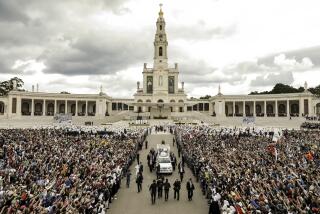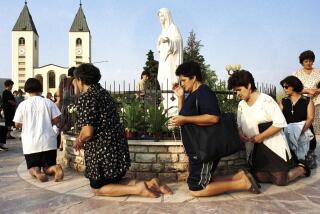A Long and Varied History of Visions
The history of heavenly apparitions in the Roman Catholic Church is long and rich. While most reports are never officially sanctioned by the church, a handful have been approved as authentic.
Many of these apparitions have certain things in common: the Virgin Mary is said to appear, alone or with Jesus. Most often, it is the powerless and impoverished who say they have seen her. She appears to them in nature--on a hillside, in a grove or in a grotto. And she delivers messages meant for the world. Usually, the messages contain some good news and some bad.
Of course, no apparition has ever been âprovedâ by scientific standards, but the sites where visions have been reported attract millions of visitors. And thousands have claimed to be cured, physically or spiritually, as a result.
In the Americas, Our Lady of Guadalupe is the premiere pilgrim site. On Dec. 9, 1531, a peasant named Juan Diego told the local bishop that he met the Virgin in the hills near what is now Mexico City. She asked him to have a church built in her honor, but the bishop wanted proof. Legend has it that Juan Diego opened his cloak to show the Virginâs image impressed upon it. And the building of a church, now Our Lady of Guadalupe basilica in Mexico City, began.
France captured world attention in the 19th Century when four separate visions of the Virgin were accepted as authentic by the church. Over a period of 41 years, she was said to appear to a nun in Paris, two children in LaSalette in Southern France, and four children on a farm in Pontmain, near the German border.
But events at Lourdes, in southwestern France, eclipsed them all. The country girl Bernadette Soubirous was not yet a teen-ager in February, 1858, when she told of seeing the Virgin in a grotto. Bernadette later described how she was directed to uncover an underground spring of water with her hands.
Since then, thousands have claimed to be healed by that water. A church-coordinated medical board tracks health records to determine whether the cures can be explained by natural, rather than supernatural, causes. The vast majority have been judged to be normal cures.
In 1917, attention swiveled to Fatima, Portugal, when three shepherd children reported seeing the Virgin once each month, from May through October. They shared messages they said she gave them, asking people to fast and pray. One message promised, âIf they listen to my requests, Russia will be converted and there will be peace.â
That was the good news from Fatima. The rest of it was awful. Unchecked disease, massive death and destruction, and fire falling from the sky were among the horrific predictions.
Some say the messages of Fatima foretell of the millennium, the end of time. Others say it predicted the spread of communism through the 20th Century.
Interest in the dark messages of Fatima has peaked again lately, perhaps in part because we are so close to the end of this century. âThe end of time as we know it has always been part of a Christian world view,â notes Anne Taves, professor of Christian church history at Claremont School of Theology. âIt was a widespread belief in Greco-Roman world, and a strong motif in the early Christian church.â
Some suggest that the calendar may even help explain the recent rise in reports of apparitions.
âThe millennium is seen as a critical time,â says Robert Ellwood, professor of Comparative Religion at University of Southern California. âThere is a sense that weâre coming to the end of an age, and changes are probably imminent. There is a lot of anxiety in the air. This opens a crack for what is outside the scientific and predictable.â
Some religion scholars with a scientific bent suggest that too many travelers to pilgrim sites fall through that crack. Among pilgrims and some other Catholics, stories abound about suns that spin in the sky, rosaries that turn gold and physical ailments that miraculously disappear.
âThis is magical thinking,â scolds Gerald Larue, head of the Committee for Scientific Examination of Religion and Emeritus Professor of Religion at USC. He has traveled to apparition sites in California and come away unconvinced. âThese claims need to be tested,â he says. âCritical thinking is the road to progress.â
Recently, a woman told Larue that her silver rosary turned gold while she was on a pilgrimage. His advice? âDip it in Tarn-X. See if itâs just tarnished beads.â
She refused, he says.
That the church hierarchy is skeptical toward visions, voices and other supernatural activity does not surprise Sister Bridget Mary Meehan of Falls Church, Va. âThe mystical is threatening because the hierarchy canât control it,â says Meehan, who studied visionaries through history for her book, âPraying With Passionate Women,â due out in January from Crossroads Press.
âTheir white-male perspective is not open to the mystical. Theyâre into the logical, not emotional. Apparitions are relational and powerful. Not analytical.â
Sidney Callahan, professor of Psychology at Mercy College in Dobbs Ferry, N.Y., agrees that the rise in reported apparitions today could reflect greater openness. But, she cautions, âThe price you pay for mysticism is, you have to live with superstitiousness.â
More to Read
Sign up for Essential California
The most important California stories and recommendations in your inbox every morning.
You may occasionally receive promotional content from the Los Angeles Times.










